300597 Master Project 1 Report: Fatigue Lifetime of Ceramic Bridges
VerifiedAdded on 2023/01/20
|42
|7193
|23
Report
AI Summary
This report, submitted for Master Project 1, investigates the fatigue lifetime prediction of all-ceramic dental bridges. It explores the current practices of ceramic use in dentistry and highlights the importance of understanding ceramic materials' mechanical properties, fabrication, and clinical performance. The study focuses on predicting the lifetime and loading capacity of all-ceramic bridges, determining flexure strength after cyclic loading, and identifying the fatigue resistance of dental ceramics. It examines the influence of cyclic loading on specimens, the correlation between microstructure and degradation, and the challenges of improving ceramic materials. The research addresses key questions about failure, strength data, lifecycle data, and fatigue resistance. The report aims to bridge the knowledge gap between ceramic material's microstructural properties and degradation to enhance the reliability and design of ceramic dental bridges, drawing on literature reviews, methodologies, and preliminary results to support its conclusions and future research plans. The project also examines the mechanical properties and fatigue behavior of different ceramics like lithium disilicate, zirconia, and polymer-infiltrated ceramic.
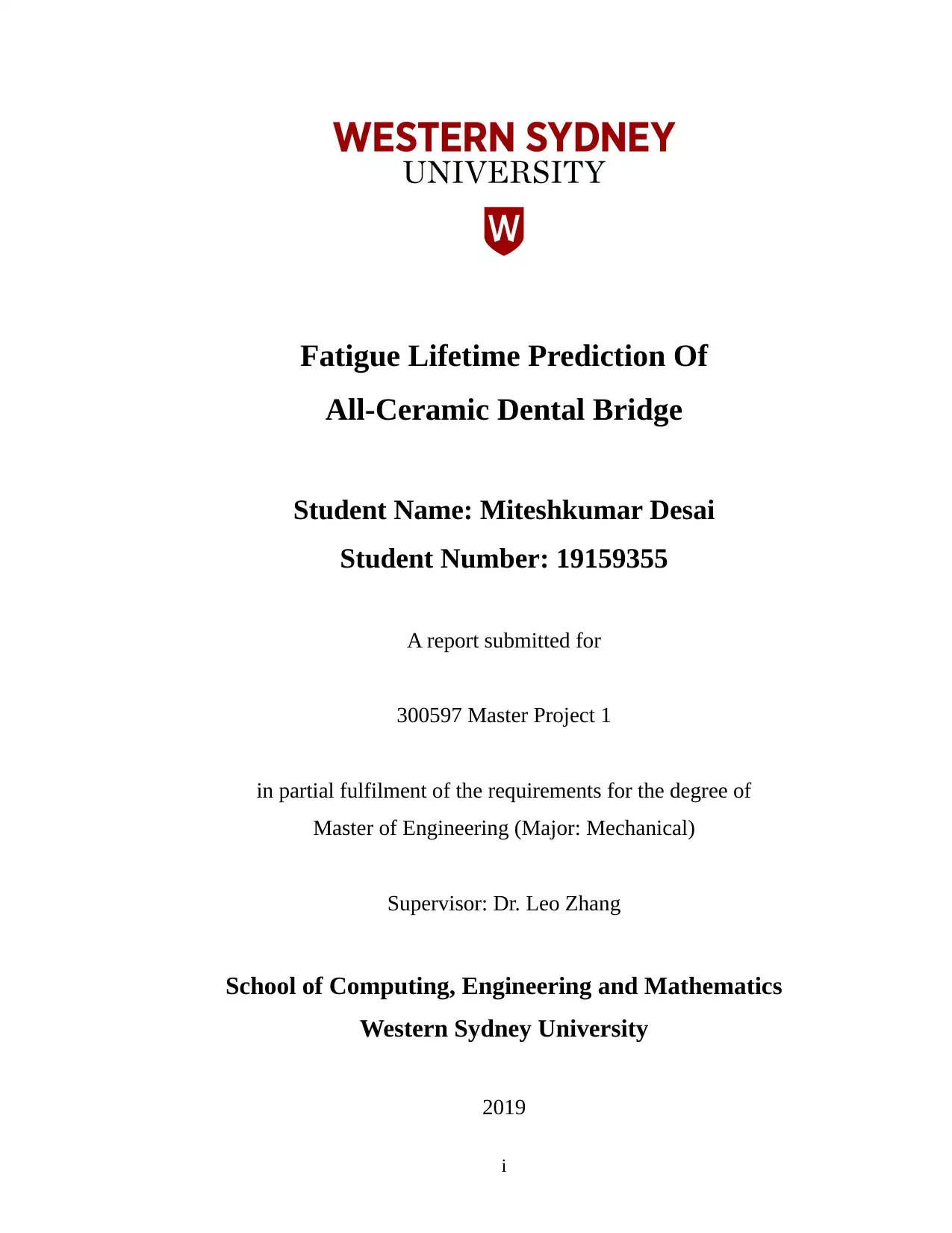
Fatigue Lifetime Prediction Of
All-Ceramic Dental Bridge
Student Name: Miteshkumar Desai
Student Number: 19159355
A report submitted for
300597 Master Project 1
in partial fulfilment of the requirements for the degree of
Master of Engineering (Major: Mechanical)
Supervisor: Dr. Leo Zhang
School of Computing, Engineering and Mathematics
Western Sydney University
2019
i
All-Ceramic Dental Bridge
Student Name: Miteshkumar Desai
Student Number: 19159355
A report submitted for
300597 Master Project 1
in partial fulfilment of the requirements for the degree of
Master of Engineering (Major: Mechanical)
Supervisor: Dr. Leo Zhang
School of Computing, Engineering and Mathematics
Western Sydney University
2019
i
Paraphrase This Document
Need a fresh take? Get an instant paraphrase of this document with our AI Paraphraser

ii
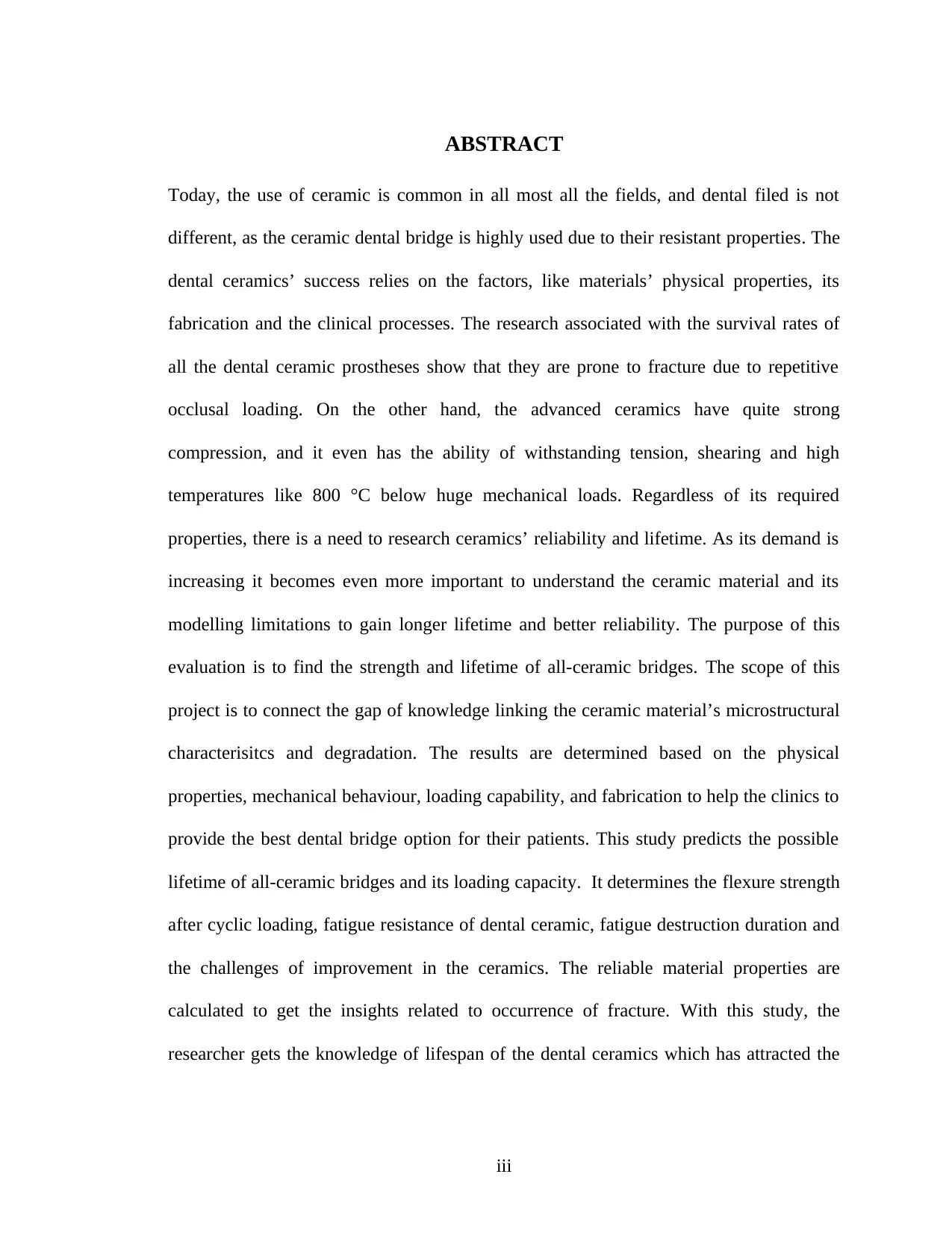
ABSTRACT
Today, the use of ceramic is common in all most all the fields, and dental filed is not
different, as the ceramic dental bridge is highly used due to their resistant properties. The
dental ceramics’ success relies on the factors, like materials’ physical properties, its
fabrication and the clinical processes. The research associated with the survival rates of
all the dental ceramic prostheses show that they are prone to fracture due to repetitive
occlusal loading. On the other hand, the advanced ceramics have quite strong
compression, and it even has the ability of withstanding tension, shearing and high
temperatures like 800 °C below huge mechanical loads. Regardless of its required
properties, there is a need to research ceramics’ reliability and lifetime. As its demand is
increasing it becomes even more important to understand the ceramic material and its
modelling limitations to gain longer lifetime and better reliability. The purpose of this
evaluation is to find the strength and lifetime of all-ceramic bridges. The scope of this
project is to connect the gap of knowledge linking the ceramic material’s microstructural
characterisitcs and degradation. The results are determined based on the physical
properties, mechanical behaviour, loading capability, and fabrication to help the clinics to
provide the best dental bridge option for their patients. This study predicts the possible
lifetime of all-ceramic bridges and its loading capacity. It determines the flexure strength
after cyclic loading, fatigue resistance of dental ceramic, fatigue destruction duration and
the challenges of improvement in the ceramics. The reliable material properties are
calculated to get the insights related to occurrence of fracture. With this study, the
researcher gets the knowledge of lifespan of the dental ceramics which has attracted the
iii
Today, the use of ceramic is common in all most all the fields, and dental filed is not
different, as the ceramic dental bridge is highly used due to their resistant properties. The
dental ceramics’ success relies on the factors, like materials’ physical properties, its
fabrication and the clinical processes. The research associated with the survival rates of
all the dental ceramic prostheses show that they are prone to fracture due to repetitive
occlusal loading. On the other hand, the advanced ceramics have quite strong
compression, and it even has the ability of withstanding tension, shearing and high
temperatures like 800 °C below huge mechanical loads. Regardless of its required
properties, there is a need to research ceramics’ reliability and lifetime. As its demand is
increasing it becomes even more important to understand the ceramic material and its
modelling limitations to gain longer lifetime and better reliability. The purpose of this
evaluation is to find the strength and lifetime of all-ceramic bridges. The scope of this
project is to connect the gap of knowledge linking the ceramic material’s microstructural
characterisitcs and degradation. The results are determined based on the physical
properties, mechanical behaviour, loading capability, and fabrication to help the clinics to
provide the best dental bridge option for their patients. This study predicts the possible
lifetime of all-ceramic bridges and its loading capacity. It determines the flexure strength
after cyclic loading, fatigue resistance of dental ceramic, fatigue destruction duration and
the challenges of improvement in the ceramics. The reliable material properties are
calculated to get the insights related to occurrence of fracture. With this study, the
researcher gets the knowledge of lifespan of the dental ceramics which has attracted the
iii
⊘ This is a preview!⊘
Do you want full access?
Subscribe today to unlock all pages.

Trusted by 1+ million students worldwide
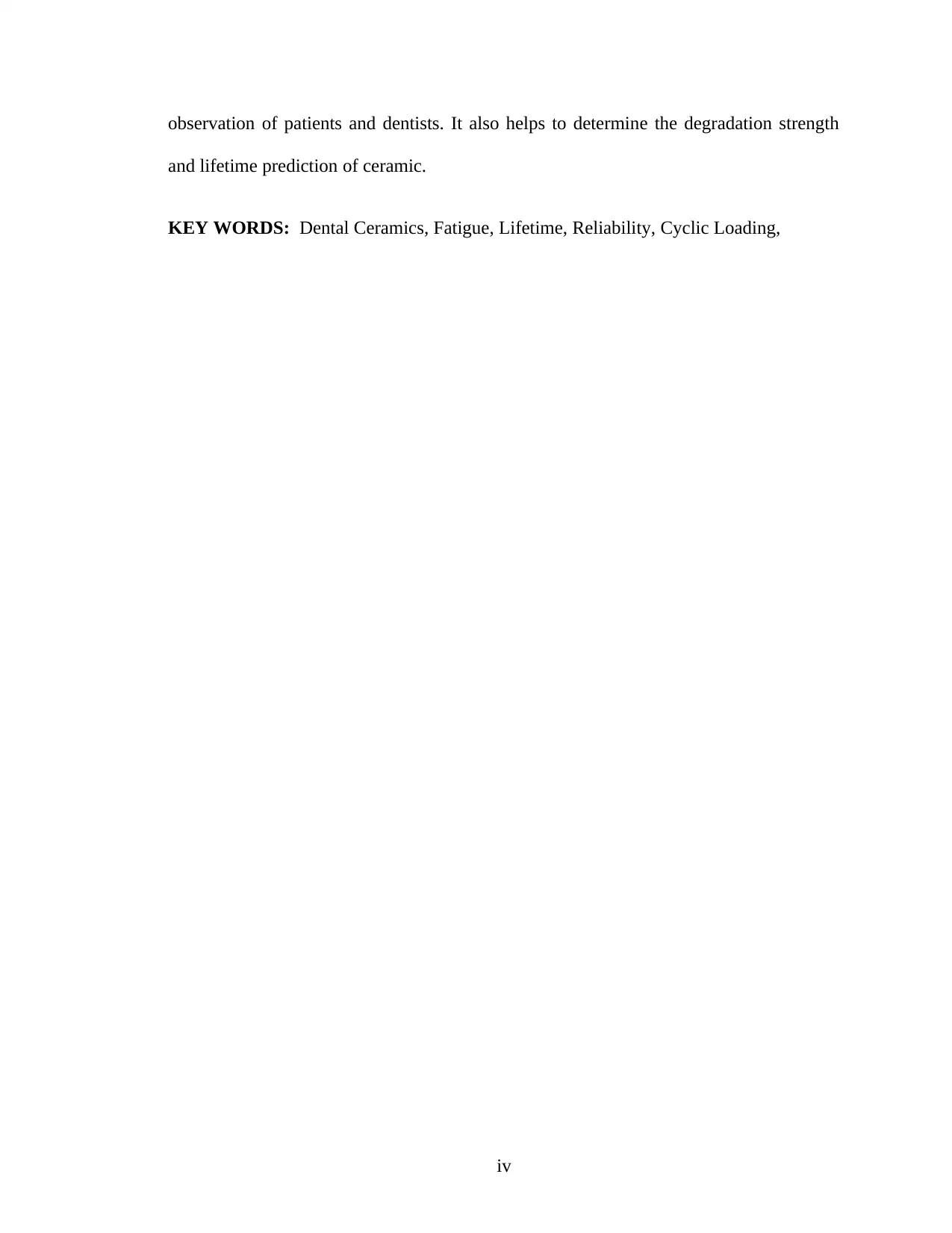
observation of patients and dentists. It also helps to determine the degradation strength
and lifetime prediction of ceramic.
KEY WORDS: Dental Ceramics, Fatigue, Lifetime, Reliability, Cyclic Loading,
iv
and lifetime prediction of ceramic.
KEY WORDS: Dental Ceramics, Fatigue, Lifetime, Reliability, Cyclic Loading,
iv
Paraphrase This Document
Need a fresh take? Get an instant paraphrase of this document with our AI Paraphraser
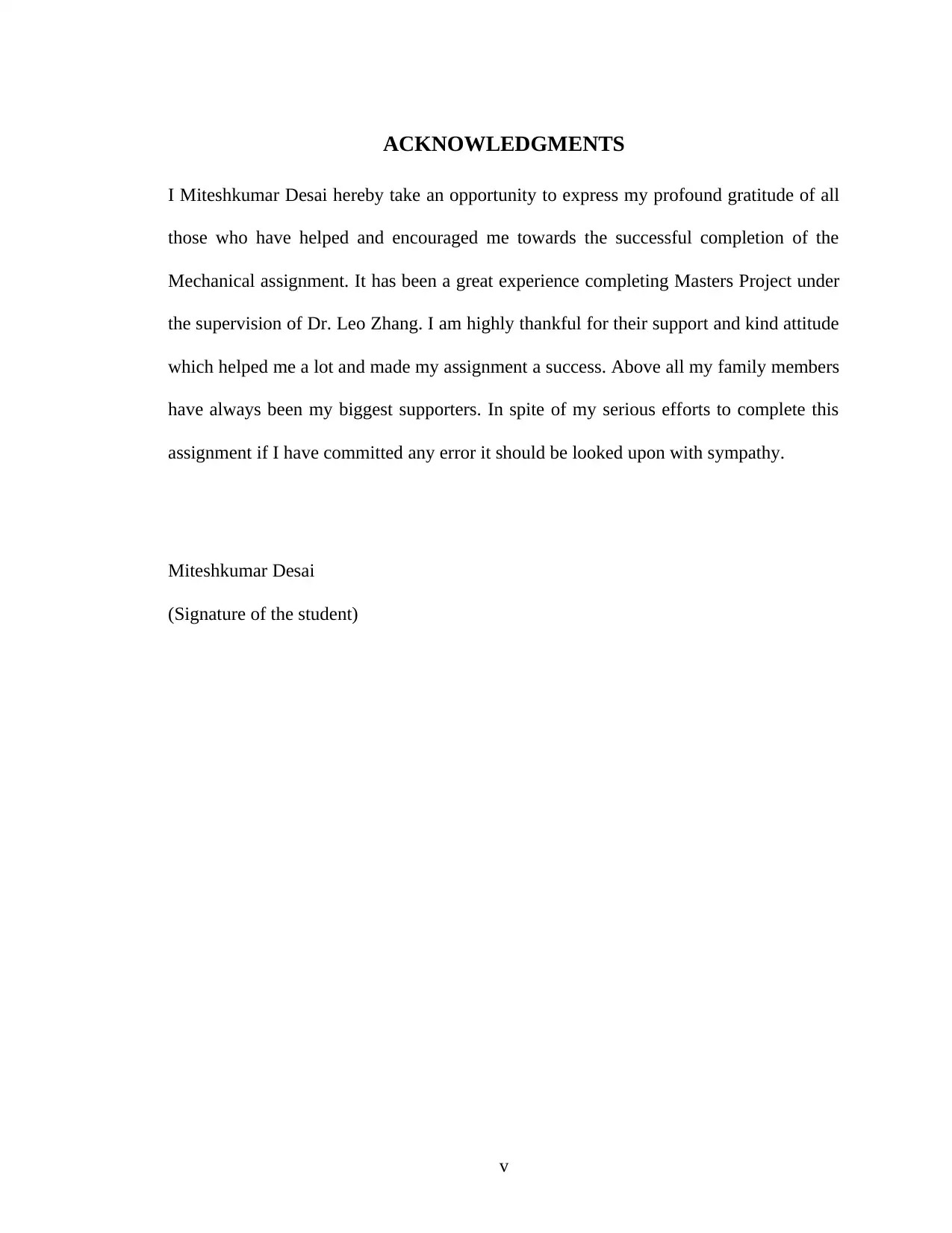
ACKNOWLEDGMENTS
I Miteshkumar Desai hereby take an opportunity to express my profound gratitude of all
those who have helped and encouraged me towards the successful completion of the
Mechanical assignment. It has been a great experience completing Masters Project under
the supervision of Dr. Leo Zhang. I am highly thankful for their support and kind attitude
which helped me a lot and made my assignment a success. Above all my family members
have always been my biggest supporters. In spite of my serious efforts to complete this
assignment if I have committed any error it should be looked upon with sympathy.
Miteshkumar Desai
(Signature of the student)
v
I Miteshkumar Desai hereby take an opportunity to express my profound gratitude of all
those who have helped and encouraged me towards the successful completion of the
Mechanical assignment. It has been a great experience completing Masters Project under
the supervision of Dr. Leo Zhang. I am highly thankful for their support and kind attitude
which helped me a lot and made my assignment a success. Above all my family members
have always been my biggest supporters. In spite of my serious efforts to complete this
assignment if I have committed any error it should be looked upon with sympathy.
Miteshkumar Desai
(Signature of the student)
v

TABLE OF CONTENTS
Chapter Page
ABSTRACT.......................................................................................................................iii
ACKNOWLEDGMENTS...................................................................................................v
TABLE OF CONTENTS...................................................................................................vi
LIST OF TABLES............................................................................................................vii
LIST OF FIGURES..........................................................................................................viii
CHAPTER I: INTRODUCTION........................................................................................1
Objective..........................................................................................................................2
Research Questions..........................................................................................................2
Hypothesis.......................................................................................................................4
CHAPTER II: LITERATURE REVIEW............................................................................5
Current Practice of Ceramic............................................................................................5
Adaptation of all-ceramic FPDs..................................................................................5
Strength, Fracture Toughness and Microstructure of Ceramic....................................6
Fatigue Behaviour........................................................................................................7
Cyclic loading’s Influence on Specimens....................................................................7
Step-stress Analysis for Predicting Dental Ceramic Reliability................................10
Ceramic Infrastructure’s Effect on Stress Distribution and Failure Behavior...........11
Correlation between fracture toughness and leucite content in dental porcelains.........11
All-ceramic bridges’ Lifetime prediction by computational methods...........................12
Fractal Analysis.............................................................................................................13
vi
Chapter Page
ABSTRACT.......................................................................................................................iii
ACKNOWLEDGMENTS...................................................................................................v
TABLE OF CONTENTS...................................................................................................vi
LIST OF TABLES............................................................................................................vii
LIST OF FIGURES..........................................................................................................viii
CHAPTER I: INTRODUCTION........................................................................................1
Objective..........................................................................................................................2
Research Questions..........................................................................................................2
Hypothesis.......................................................................................................................4
CHAPTER II: LITERATURE REVIEW............................................................................5
Current Practice of Ceramic............................................................................................5
Adaptation of all-ceramic FPDs..................................................................................5
Strength, Fracture Toughness and Microstructure of Ceramic....................................6
Fatigue Behaviour........................................................................................................7
Cyclic loading’s Influence on Specimens....................................................................7
Step-stress Analysis for Predicting Dental Ceramic Reliability................................10
Ceramic Infrastructure’s Effect on Stress Distribution and Failure Behavior...........11
Correlation between fracture toughness and leucite content in dental porcelains.........11
All-ceramic bridges’ Lifetime prediction by computational methods...........................12
Fractal Analysis.............................................................................................................13
vi
⊘ This is a preview!⊘
Do you want full access?
Subscribe today to unlock all pages.

Trusted by 1+ million students worldwide

Ceramics fracture Criteria..............................................................................................13
CHAPTER III: METHODOLOGY...................................................................................14
CHAPTER IV: PRELIMINARY RESULT......................................................................17
CHAPTER V: SUMAMRY AND RESEARCH PLAN...................................................21
REFERENCES..................................................................................................................24
Appendix A: HEADING...................................................................................................28
vii
CHAPTER III: METHODOLOGY...................................................................................14
CHAPTER IV: PRELIMINARY RESULT......................................................................17
CHAPTER V: SUMAMRY AND RESEARCH PLAN...................................................21
REFERENCES..................................................................................................................24
Appendix A: HEADING...................................................................................................28
vii
Paraphrase This Document
Need a fresh take? Get an instant paraphrase of this document with our AI Paraphraser
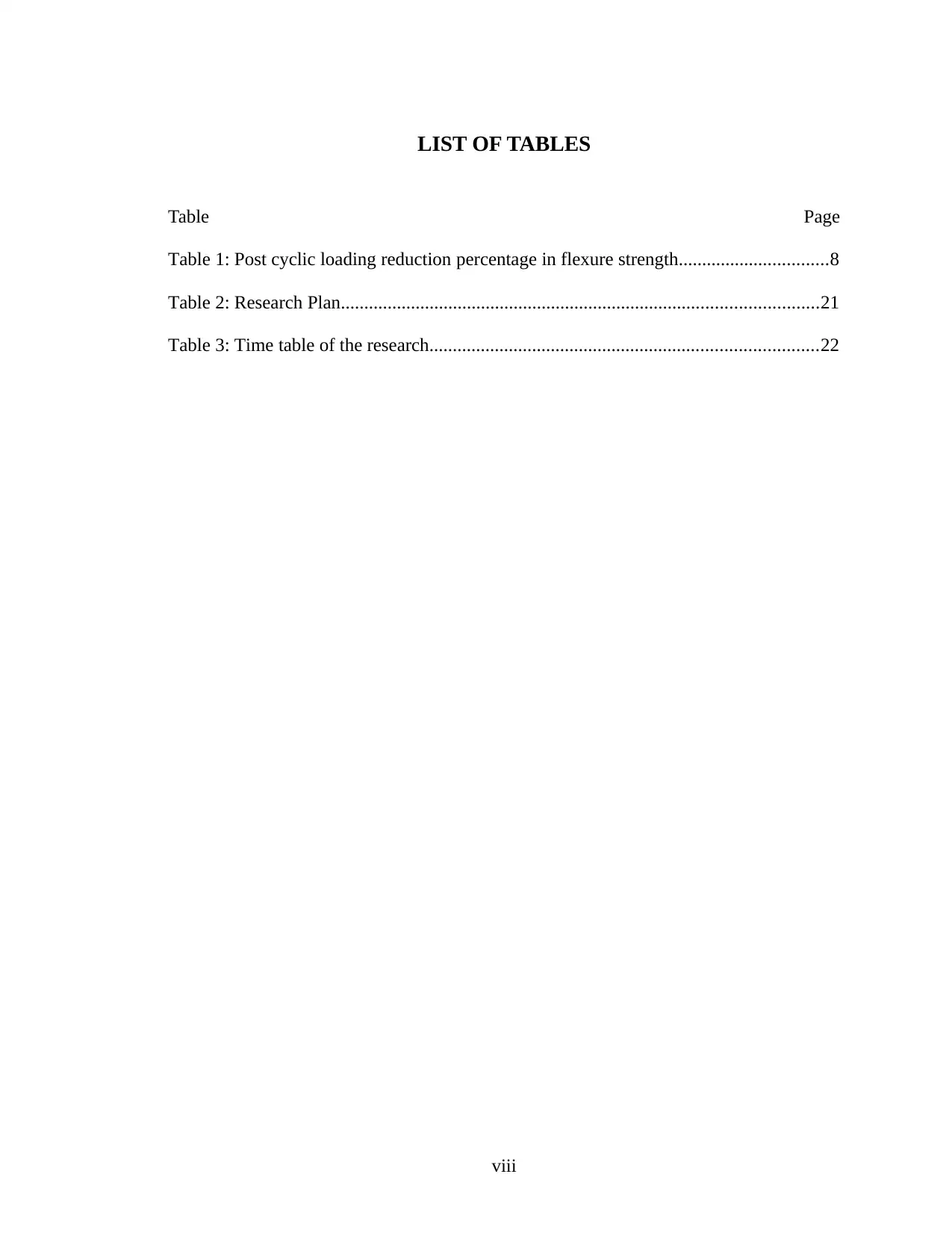
LIST OF TABLES
Table Page
Table 1: Post cyclic loading reduction percentage in flexure strength................................8
Table 2: Research Plan......................................................................................................21
Table 3: Time table of the research...................................................................................22
viii
Table Page
Table 1: Post cyclic loading reduction percentage in flexure strength................................8
Table 2: Research Plan......................................................................................................21
Table 3: Time table of the research...................................................................................22
viii
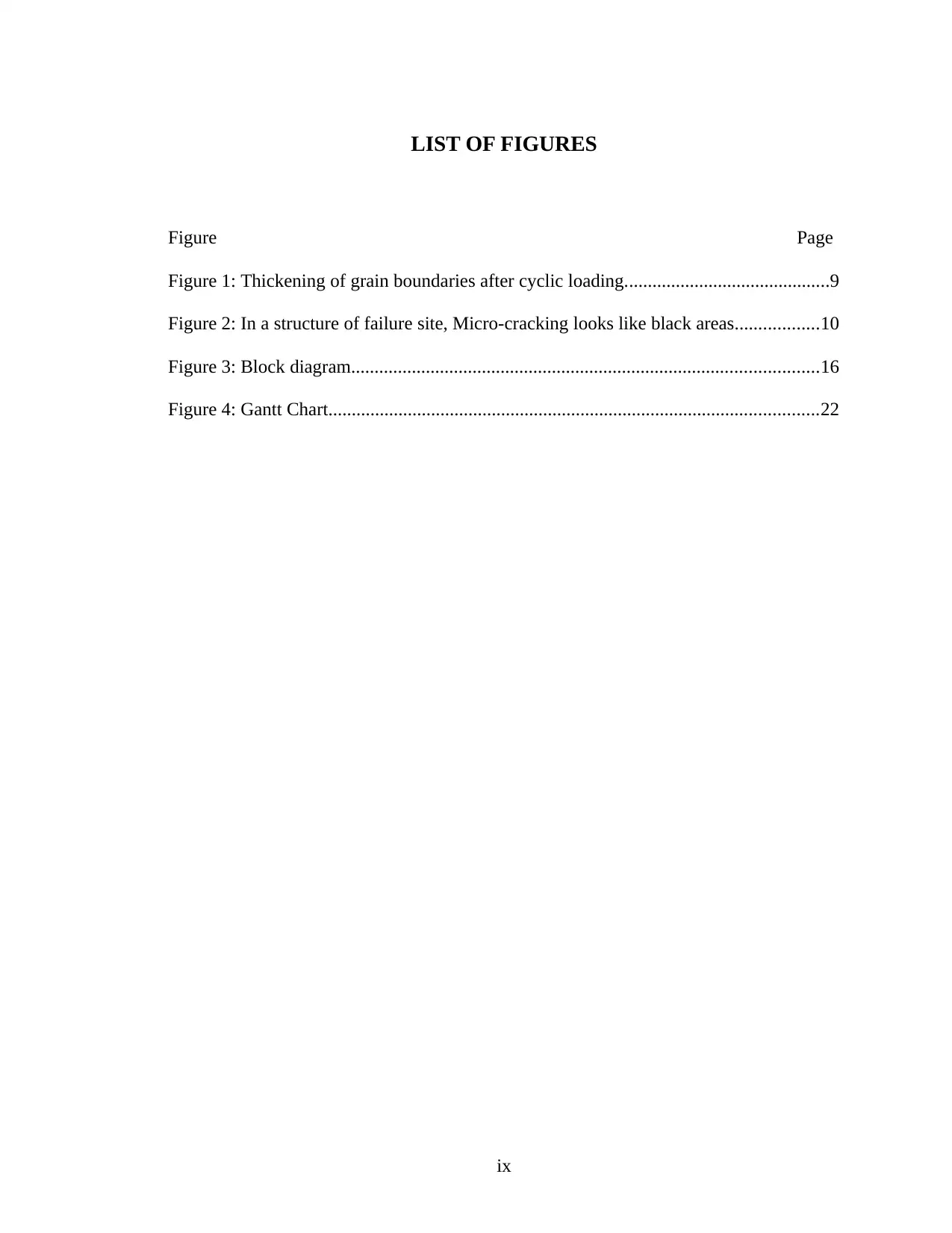
LIST OF FIGURES
Figure Page
Figure 1: Thickening of grain boundaries after cyclic loading............................................9
Figure 2: In a structure of failure site, Micro-cracking looks like black areas..................10
Figure 3: Block diagram....................................................................................................16
Figure 4: Gantt Chart.........................................................................................................22
ix
Figure Page
Figure 1: Thickening of grain boundaries after cyclic loading............................................9
Figure 2: In a structure of failure site, Micro-cracking looks like black areas..................10
Figure 3: Block diagram....................................................................................................16
Figure 4: Gantt Chart.........................................................................................................22
ix
⊘ This is a preview!⊘
Do you want full access?
Subscribe today to unlock all pages.

Trusted by 1+ million students worldwide
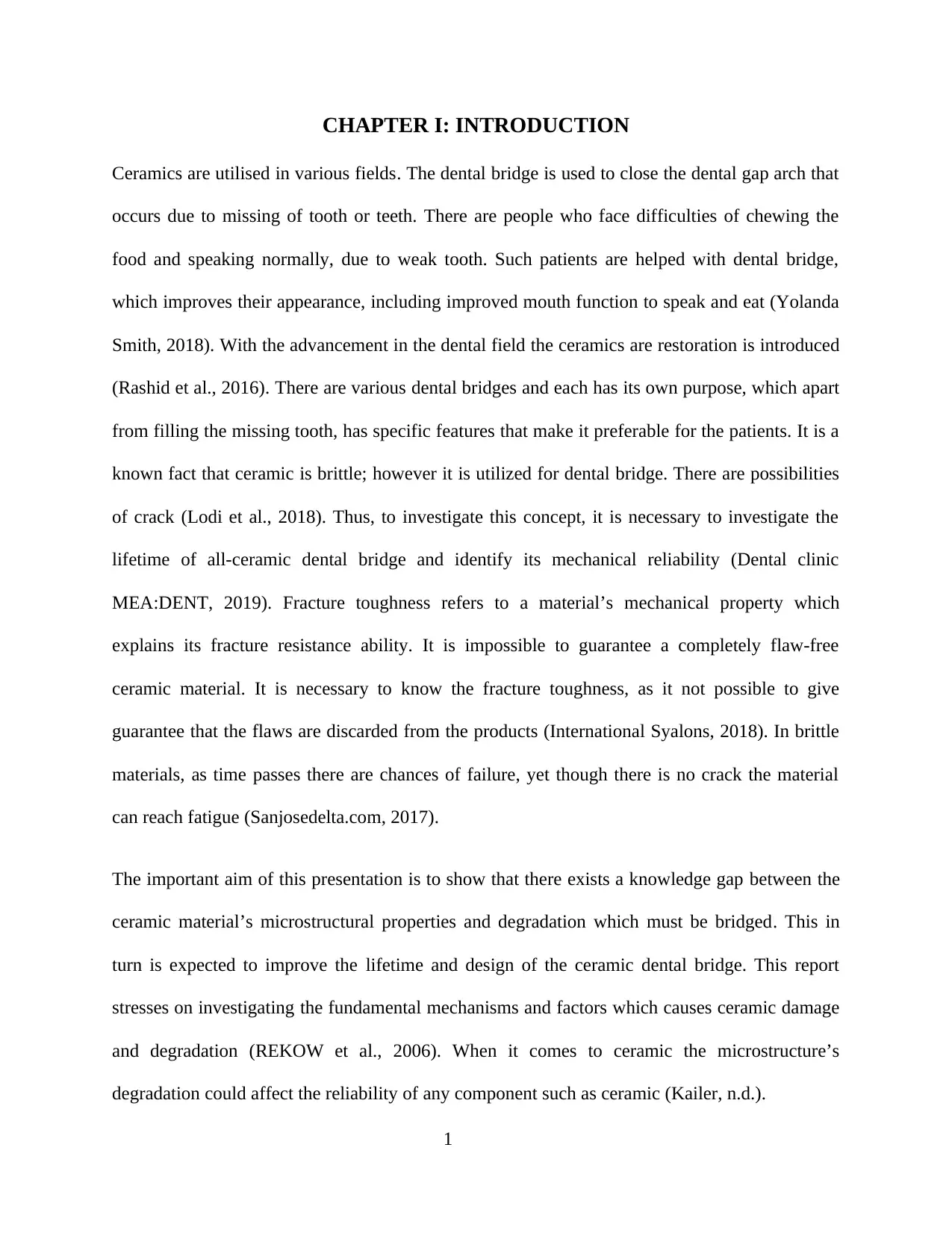
CHAPTER I: INTRODUCTION
Ceramics are utilised in various fields. The dental bridge is used to close the dental gap arch that
occurs due to missing of tooth or teeth. There are people who face difficulties of chewing the
food and speaking normally, due to weak tooth. Such patients are helped with dental bridge,
which improves their appearance, including improved mouth function to speak and eat (Yolanda
Smith, 2018). With the advancement in the dental field the ceramics are restoration is introduced
(Rashid et al., 2016). There are various dental bridges and each has its own purpose, which apart
from filling the missing tooth, has specific features that make it preferable for the patients. It is a
known fact that ceramic is brittle; however it is utilized for dental bridge. There are possibilities
of crack (Lodi et al., 2018). Thus, to investigate this concept, it is necessary to investigate the
lifetime of all-ceramic dental bridge and identify its mechanical reliability (Dental clinic
MEA:DENT, 2019). Fracture toughness refers to a material’s mechanical property which
explains its fracture resistance ability. It is impossible to guarantee a completely flaw-free
ceramic material. It is necessary to know the fracture toughness, as it not possible to give
guarantee that the flaws are discarded from the products (International Syalons, 2018). In brittle
materials, as time passes there are chances of failure, yet though there is no crack the material
can reach fatigue (Sanjosedelta.com, 2017).
The important aim of this presentation is to show that there exists a knowledge gap between the
ceramic material’s microstructural properties and degradation which must be bridged. This in
turn is expected to improve the lifetime and design of the ceramic dental bridge. This report
stresses on investigating the fundamental mechanisms and factors which causes ceramic damage
and degradation (REKOW et al., 2006). When it comes to ceramic the microstructure’s
degradation could affect the reliability of any component such as ceramic (Kailer, n.d.).
1
Ceramics are utilised in various fields. The dental bridge is used to close the dental gap arch that
occurs due to missing of tooth or teeth. There are people who face difficulties of chewing the
food and speaking normally, due to weak tooth. Such patients are helped with dental bridge,
which improves their appearance, including improved mouth function to speak and eat (Yolanda
Smith, 2018). With the advancement in the dental field the ceramics are restoration is introduced
(Rashid et al., 2016). There are various dental bridges and each has its own purpose, which apart
from filling the missing tooth, has specific features that make it preferable for the patients. It is a
known fact that ceramic is brittle; however it is utilized for dental bridge. There are possibilities
of crack (Lodi et al., 2018). Thus, to investigate this concept, it is necessary to investigate the
lifetime of all-ceramic dental bridge and identify its mechanical reliability (Dental clinic
MEA:DENT, 2019). Fracture toughness refers to a material’s mechanical property which
explains its fracture resistance ability. It is impossible to guarantee a completely flaw-free
ceramic material. It is necessary to know the fracture toughness, as it not possible to give
guarantee that the flaws are discarded from the products (International Syalons, 2018). In brittle
materials, as time passes there are chances of failure, yet though there is no crack the material
can reach fatigue (Sanjosedelta.com, 2017).
The important aim of this presentation is to show that there exists a knowledge gap between the
ceramic material’s microstructural properties and degradation which must be bridged. This in
turn is expected to improve the lifetime and design of the ceramic dental bridge. This report
stresses on investigating the fundamental mechanisms and factors which causes ceramic damage
and degradation (REKOW et al., 2006). When it comes to ceramic the microstructure’s
degradation could affect the reliability of any component such as ceramic (Kailer, n.d.).
1
Paraphrase This Document
Need a fresh take? Get an instant paraphrase of this document with our AI Paraphraser
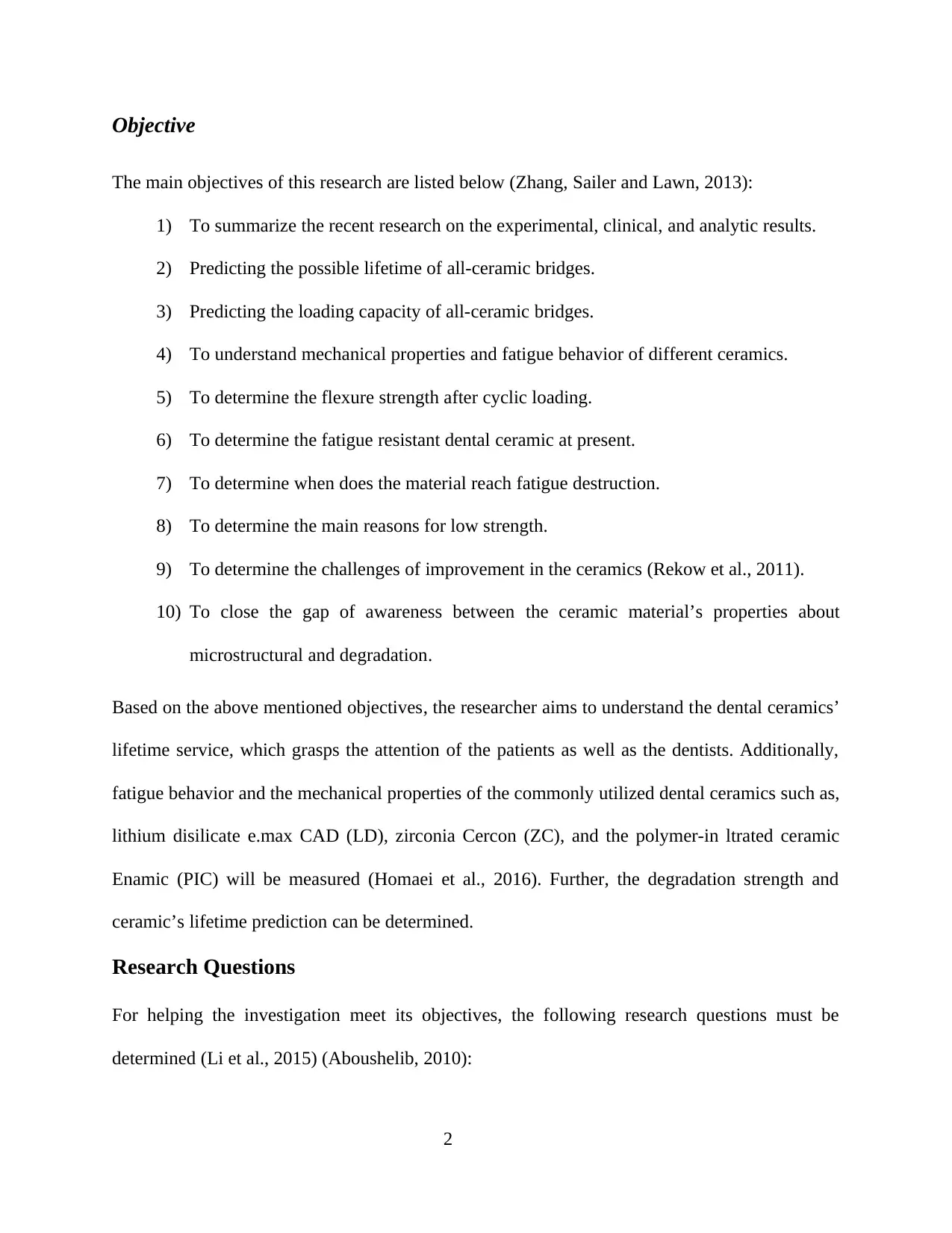
Objective
The main objectives of this research are listed below (Zhang, Sailer and Lawn, 2013):
1) To summarize the recent research on the experimental, clinical, and analytic results.
2) Predicting the possible lifetime of all-ceramic bridges.
3) Predicting the loading capacity of all-ceramic bridges.
4) To understand mechanical properties and fatigue behavior of different ceramics.
5) To determine the flexure strength after cyclic loading.
6) To determine the fatigue resistant dental ceramic at present.
7) To determine when does the material reach fatigue destruction.
8) To determine the main reasons for low strength.
9) To determine the challenges of improvement in the ceramics (Rekow et al., 2011).
10) To close the gap of awareness between the ceramic material’s properties about
microstructural and degradation.
Based on the above mentioned objectives, the researcher aims to understand the dental ceramics’
lifetime service, which grasps the attention of the patients as well as the dentists. Additionally,
fatigue behavior and the mechanical properties of the commonly utilized dental ceramics such as,
lithium disilicate e.max CAD (LD), zirconia Cercon (ZC), and the polymer-in ltrated ceramic
Enamic (PIC) will be measured (Homaei et al., 2016). Further, the degradation strength and
ceramic’s lifetime prediction can be determined.
Research Questions
For helping the investigation meet its objectives, the following research questions must be
determined (Li et al., 2015) (Aboushelib, 2010):
2
The main objectives of this research are listed below (Zhang, Sailer and Lawn, 2013):
1) To summarize the recent research on the experimental, clinical, and analytic results.
2) Predicting the possible lifetime of all-ceramic bridges.
3) Predicting the loading capacity of all-ceramic bridges.
4) To understand mechanical properties and fatigue behavior of different ceramics.
5) To determine the flexure strength after cyclic loading.
6) To determine the fatigue resistant dental ceramic at present.
7) To determine when does the material reach fatigue destruction.
8) To determine the main reasons for low strength.
9) To determine the challenges of improvement in the ceramics (Rekow et al., 2011).
10) To close the gap of awareness between the ceramic material’s properties about
microstructural and degradation.
Based on the above mentioned objectives, the researcher aims to understand the dental ceramics’
lifetime service, which grasps the attention of the patients as well as the dentists. Additionally,
fatigue behavior and the mechanical properties of the commonly utilized dental ceramics such as,
lithium disilicate e.max CAD (LD), zirconia Cercon (ZC), and the polymer-in ltrated ceramic
Enamic (PIC) will be measured (Homaei et al., 2016). Further, the degradation strength and
ceramic’s lifetime prediction can be determined.
Research Questions
For helping the investigation meet its objectives, the following research questions must be
determined (Li et al., 2015) (Aboushelib, 2010):
2
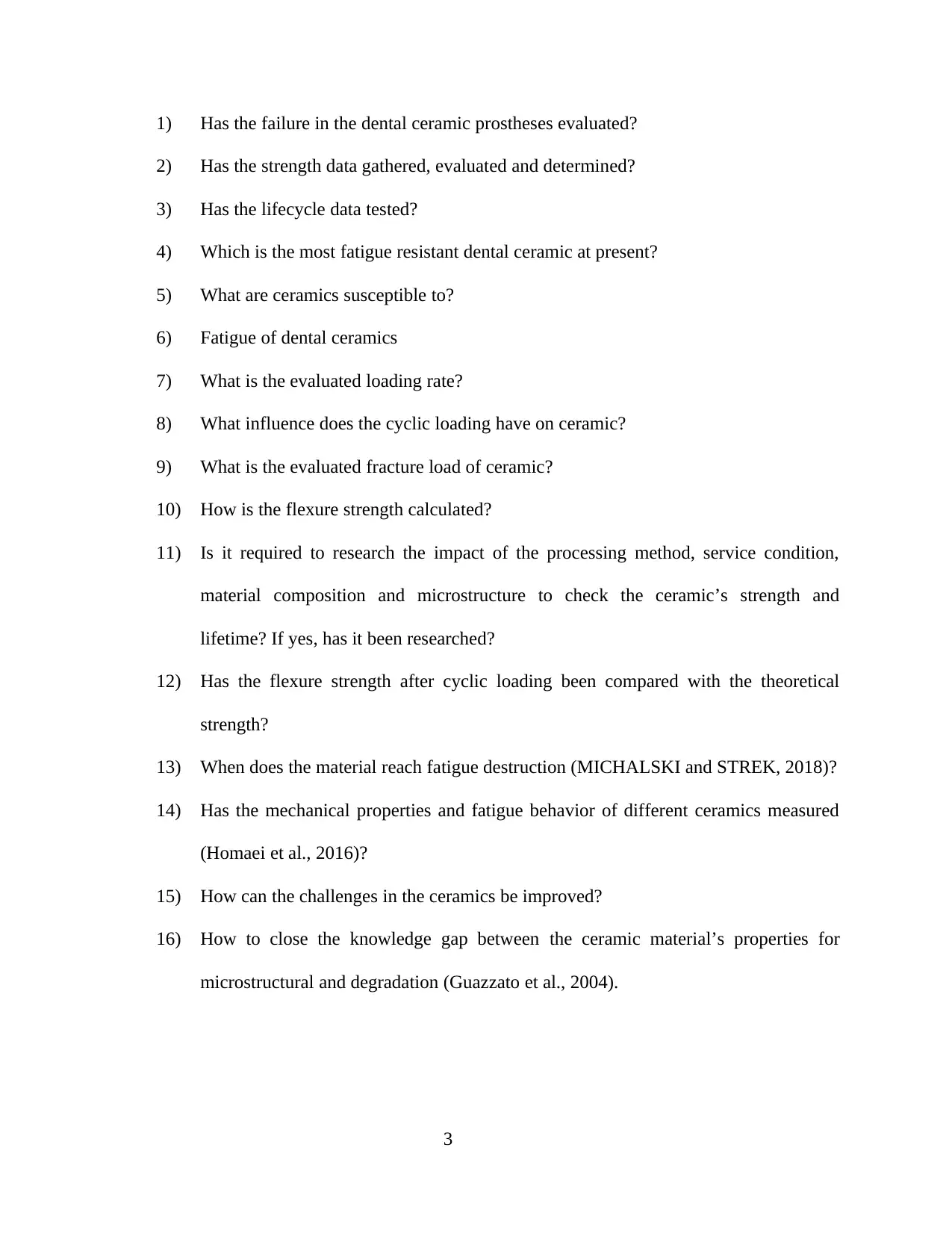
1) Has the failure in the dental ceramic prostheses evaluated?
2) Has the strength data gathered, evaluated and determined?
3) Has the lifecycle data tested?
4) Which is the most fatigue resistant dental ceramic at present?
5) What are ceramics susceptible to?
6) Fatigue of dental ceramics
7) What is the evaluated loading rate?
8) What influence does the cyclic loading have on ceramic?
9) What is the evaluated fracture load of ceramic?
10) How is the flexure strength calculated?
11) Is it required to research the impact of the processing method, service condition,
material composition and microstructure to check the ceramic’s strength and
lifetime? If yes, has it been researched?
12) Has the flexure strength after cyclic loading been compared with the theoretical
strength?
13) When does the material reach fatigue destruction (MICHALSKI and STREK, 2018)?
14) Has the mechanical properties and fatigue behavior of different ceramics measured
(Homaei et al., 2016)?
15) How can the challenges in the ceramics be improved?
16) How to close the knowledge gap between the ceramic material’s properties for
microstructural and degradation (Guazzato et al., 2004).
3
2) Has the strength data gathered, evaluated and determined?
3) Has the lifecycle data tested?
4) Which is the most fatigue resistant dental ceramic at present?
5) What are ceramics susceptible to?
6) Fatigue of dental ceramics
7) What is the evaluated loading rate?
8) What influence does the cyclic loading have on ceramic?
9) What is the evaluated fracture load of ceramic?
10) How is the flexure strength calculated?
11) Is it required to research the impact of the processing method, service condition,
material composition and microstructure to check the ceramic’s strength and
lifetime? If yes, has it been researched?
12) Has the flexure strength after cyclic loading been compared with the theoretical
strength?
13) When does the material reach fatigue destruction (MICHALSKI and STREK, 2018)?
14) Has the mechanical properties and fatigue behavior of different ceramics measured
(Homaei et al., 2016)?
15) How can the challenges in the ceramics be improved?
16) How to close the knowledge gap between the ceramic material’s properties for
microstructural and degradation (Guazzato et al., 2004).
3
⊘ This is a preview!⊘
Do you want full access?
Subscribe today to unlock all pages.

Trusted by 1+ million students worldwide
1 out of 42
Your All-in-One AI-Powered Toolkit for Academic Success.
+13062052269
info@desklib.com
Available 24*7 on WhatsApp / Email
![[object Object]](/_next/static/media/star-bottom.7253800d.svg)
Unlock your academic potential
Copyright © 2020–2026 A2Z Services. All Rights Reserved. Developed and managed by ZUCOL.

